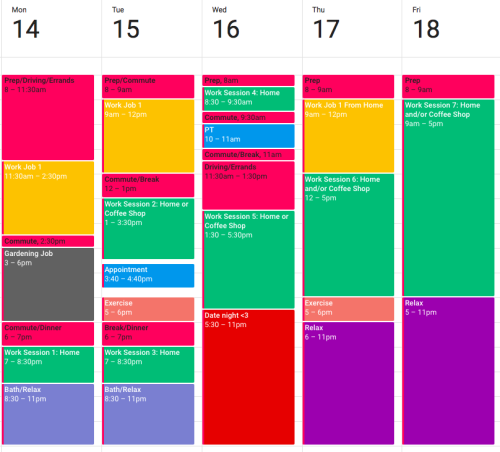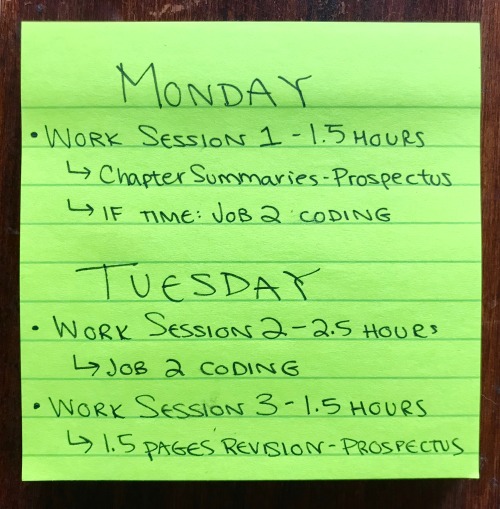May’s theme is Making Goal Setting Work for Me.
Last week’s post taught me a lot about planning long-term goals, but right now I’m juggling multiple projects with deadlines in the next 2-4 weeks. Totally different animal!
I use an amalgamation of scheduling tools: a hanging wall calendar at home, GoogleCalendar at work, and ToDoist for daily tasks. In the past, I’ve experimented with the Passion Planner, and I’ve been tracking habits a’la Bullet Journal in my little pink book. I knew I needed to streamline my scheduling practice to make it efficient and easy to follow, and I spent last week practicing how to schedule. I’m stoked to share the really helpful scheduling tools with you!
Do a Little Each Day
I can’t remember the last time that I had only one project on the books. I bet you’ve also experienced the feeling of being pulled in multiple directions: if I’m working on Project A, then I’m not advancing on Project B…but if I only do Project B, then I will fall behind in Project C! Ahh!
I had no idea how to handle this, so I bought my very efficient friend Liz a coffee and had her tutor me in scheduling. Here’s her tips:
First: Look at your schedule and see the open pockets of time. Think about what you can do in them. The key is to be realistic about the amount of work you can actually accomplish (be sure to include self care and breaks!). Since I use the Pomodoro method, I know that I will be taking short breaks throughout my work sessions. Here’s an example of my plan for this week:

Second: Use Todoist to break down what tasks you will do when. Be sure to put tasks in an order that makes sense. Since I know my prospectus is my priority right now, I’m going to work on it first and later move on to my other work.

Third: Instead of going H.A.M. (hard as a m*ther f*cker) and expending all of your energy on one project, plan ahead and tackle projects in manageable chunks every day. Using this method last week, I completed 4 tasks in 6.5 hours, spending 90 minutes each on my prospectus, consulting, grading, and then one hour on blogging. There was a hour’s worth of breaks spread throughout to include a shower, lunch, walking the dog, and meditating. Even though I didn’t completely finish any of those 4 tasks, I made a sizable dent in all of them, rather than working my brain down on one task and passing my point of diminishing returns. This is important, because it helps me to counteract my own planning fallacy.
Planning Fallacy
The planning fallacy means that we underestimate how long a particular task will take us to complete. We do this because we feel optimistic and are biased that we ourselves can complete a task in a short time frame. This could be because we forget to factor in how long it will take us to complete non-project related tasks (cooking, commuting, cleaning, resting, etc.) and because we are so optimistic that we forget that history proves we need longer time to complete similar tasks.
Here’s an example: When I started my areas (comprehensive exams), I told my friends “I’ll have this done in a few weeks.” All I had to do was read 60 texts and write two 15 page papers–I was used to writing 15 page final papers over a weekend and I had regularly read 10 texts in a week for graduate classes. How different could reading for areas be? The answer: a lot. I ended up spending about a year researching, writing, and revising my area papers.
I do this with work all the time. I choose arbitrary deadlines (“I’ll get this to you by the end of the day”) and then scramble to meet them or push them back–neither of which feel good. I could easily have said “I’ll have this to you in 3 days” and received a genuine “sounds great!”–but I set way too early of a deadline because I wanted it to be true. Being aware of the planning fallacy helps me wait a beat and check in with reality before I set a deadline.
The 5 Second Rule
Mel Robbins is an extremely successful motivational speaker who created the “5 Second Rule.” She breaks down the concept well in this video, but basically it is a tool that aims to help us make a decision by simply taking action. If you remember back to my post on Habits 101, you know that cues beget routines beget rewards. By counting “5-4-3-2-1” and then exiting out of Instagram, getting up to wash the dishes, starting that email to a colleague, or putting on our gym shoes, we “interrupt the old behavior pattern and trigger a new one” (Robbins). This creates activation energy, which is what motivates our asses to start and keep doing something. I’ve been practicing this for a few days and it is definitely helping me to stop procrastinating. Before I count backwards, I quickly check in with myself about whether an action will benefit me and ultimately help me: if I’m perusing Instagram while I’m taking a planned break, I don’t do it; if I’m using social media as a procrastination tool when I want to be working, I 5-4-3-2-1 it.

What Is *Your* Approach to Scheduling?
Remember how I always said “I’m more of a rhythm than routine girl”? Well, I’m expanding my horizons—at least right now when I’m juggling so many tasks!
Regardless if you feel like you love, hate, or feel “meh” about breaking your days up into schedules, I encourage you to journal or think on the following questions so you can individualize your scheduling practice.
- Why do I personally struggle with scheduling?
- What do I wish I could do with scheduling?
- When do I usually feel super stressed about meeting deadlines?
Once you have your answers, scroll back up to read through my three tools: Do a Little Each Day, Planning Fallacy, and 5 Second Rule. Imagine how you could adapt each of these three as a solution to your answers about struggling, wishing, or stressing out.
Figure Out Your Schedule
Look at your weekly schedule. Are there spaces where you can schedule Work Sessions? Number them like I did up above. Being sure to leave time for commuting, self care, and errands, start assigning tasks to those work sessions.
If you use a Pomodoro-style timer you can get a lot of work done while allowing short breaks. I use the free BeFocused app on my phone, but this Tomato Timer website works, too. access
Use the 5 Second Rule to Stop Procrastinating
We build habits via cues, routines, and rewards. Procrastination is a short-term reward: it prevents us from doing work we don’t want to do! But, it also prevents us from accomplishing our bigger goals. If you’re working and go to open up social media in your phone or computer, recognize you’re procrastinating, decide what you want to do instead (put down your phone/close that social media tab/put on your Freedom app to block social media sites) and count down 5-4-3-2-1-Go. On Go, you take action. I literally will count down out loud, so try that, too!
*Please note that the original version of this blog post was published here.
This blog is not affiliated with, associated with, or endorsed by the Pomodoro Technique® or Francesco Cirillo.
Newsletter
Sign up below to access my free newsletter, Tending with Dr. Kate Henry.

